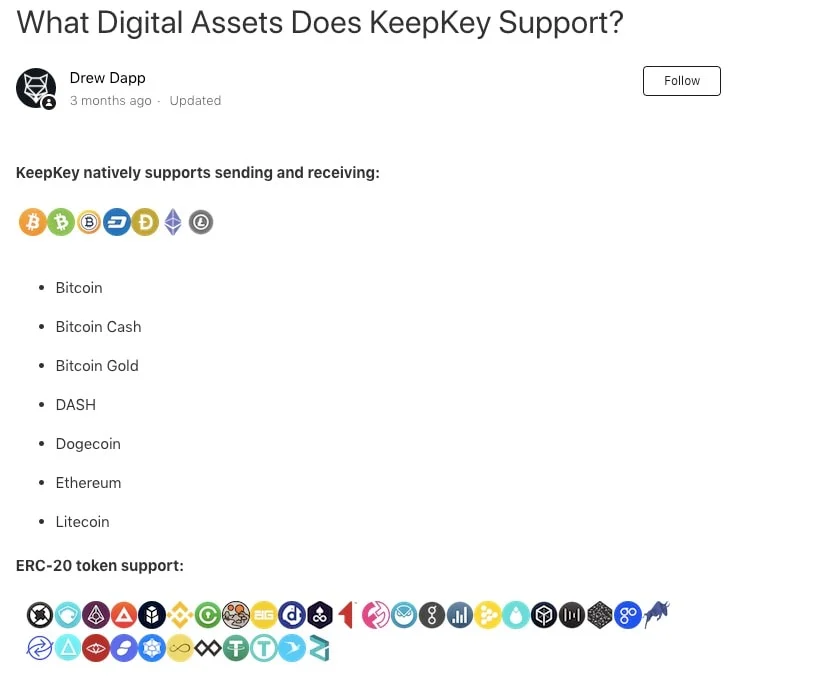KeepKey is a cryptocurrency hardware wallet released in 2015. In 2025 it remains a budget-friendly option, priced at around US$78. It offers a large OLED screen, simple one-button design, and integration with the ShapeShift platform for easy crypto swaps. Despite improvements in asset support—now covering over 7,000 assets across 350+ blockchains—it still lags behind competitors like Ledger Nano X and Trezor Safe 5 in security, lacking a Secure Element chip. KeepKey firmware is open source and regularly updated, with the latest version supporting Thorchain integration.
KeepKey is maintained under ShapeShift’s decentralized governance model, which began in 2021. While the company’s future once seemed uncertain, the wallet continues to receive support and remains available through the ShapeShift platform. It is best suited for users who prioritize simplicity and affordability over advanced features or high-security standards.
Key features of the KeepKey
- Large OLED Display: The 3.12-inch screen clearly shows full wallet addresses and transaction details, reducing the risk of errors during transfers. This is especially helpful for beginners and long-term holders who value visibility and simplicity.
- Simple One-Button Interface: KeepKey uses a single physical button for confirmations, making it easy to navigate without the risk of accidental approvals. Most actions are handled through the KeepKey Desktop app.
- ShapeShift Integration: Users can swap cryptocurrencies directly within the wallet using Thorchain integration, without needing to move funds to an exchange. This feature is available through the KeepKey Desktop app.
- Open-Source Firmware: KeepKey’s firmware and software are fully open source, allowing for community review and transparency. This appeals to users who prioritize auditability over proprietary security chips4.
- PIN and Passphrase Protection: The wallet supports PIN codes and optional passphrases for added security. It also uses randomized PIN entry to protect against keyloggers.
- Offline Key Generation: Private keys are generated and stored completely offline, keeping them safe from malware and online threats.
- Cross-Platform Compatibility: Works with Windows, macOS, Linux, and Android. Setup and management are done through the official KeepKey Desktop app.
- No Secure Element Chip: Unlike newer wallets, KeepKey does not include a secure element. While this aligns with its open-source philosophy, it may be a drawback for users seeking hardware-level tamper resistance.
- Larger screen– Displays full cryptocurrency addresses without scrolling
- Weighty luxury feel– Smooth finish and does not feel like it would break easily.
Packaging
KeepKey continues to ship in secure, tamper-evident packaging. The retail box includes security seals on two sides to ensure the device has not been opened or altered before delivery. Inside the box, you will find:
- The KeepKey hardware wallet
- A USB-A to USB-C braided nylon cable for connecting to your computer
- A recovery seed card for writing down your 12-word recovery phrase
- A warranty card
- A leather sleeve to store your recovery card securely
The packaging remains minimal yet functional, designed to protect the device during shipping while offering a clean unboxing experience. As of 2025, KeepKey has not announced any changes to its packaging materials in response to global sustainability regulations, and no biodegradable or recycled packaging components have been introduced.
At the time of launch in 2015, KeepKey retailed a high price. With more established competitors, the price is now considerably lower at US$78.
This is more affordable than the Ledger Nano X at US$149 and Trezor Safe 5 at US$169, albeit they are newer.
Security Features
Here are some of the security features found in the KeepKey:
- Offline Key Storage: KeepKey stores your private keys in an air-gapped environment, completely isolated from internet-connected devices. This ensures your keys never leave the device.
- PIN Code Protection: Access to the wallet is secured by a user-defined PIN. KeepKey uses randomized PIN entry on-screen to prevent keylogging attacks.
- 12-Word Recovery Phrase: During setup, users receive a 12-word recovery phrase that can be used to restore access if the device is lost or damaged. KeepKey recommends storing this phrase offline and securely.
- Firmware Security Updates: The latest firmware version, 6.4.1, patched a previously disclosed PIN verification vulnerability. This update strengthens protection against side-channel attacks that could extract PIN data from voltage readings.
- No Secure Element Chip: Unlike newer wallets, KeepKey does not include a Secure Element chip. This design choice aligns with its open-source philosophy but may offer less resistance to physical tampering.
- Open-Source Codebase: KeepKey’s firmware and client software are fully open source, allowing for community review and transparency.
- Physical Vulnerability Disclosure: A known hardware-level vulnerability—shared with Trezor devices—allows recovery phrase extraction if an attacker has physical access. This issue is unpatchable due to the device’s architecture. Users are advised to store their KeepKey in a secure physical location.
KeepKey PIN Vulnerability Discovered by Ledger team
In 2020, Ledger’s (yes, the ones behind the Ledger Nano X) security research team, Donjon, discovered a side-channel vulnerability in the KeepKey hardware wallet’s PIN verification process. This flaw allowed attackers with physical access to extract the user’s PIN by analyzing the device’s power consumption during PIN checks. The attack used a technique called profiled side-channel analysis, which compared voltage outputs to a pre-built database of known values.
ShapeShift, the manufacturer of KeepKey, responded by releasing firmware version 6.4.1, which patched the PIN verification vulnerability. Users who have updated to this version or later are protected from this specific attack. However, a separate unfixable vulnerability remains: if an attacker gains physical access to the device, they may still be able to extract the recovery phrase due to the lack of a Secure Element chip.
To stay protected:
- Update to firmware 6.4.1 or later
- Use a strong passphrase in addition to your PIN
- Keep your device physically secure at all times
ShapeShift, the manufacturers of the KeepKey have patched the PIN verification vulnerability in their firmware version 6.4.1. Despite this, we have to give a security rating of 3 out of 5 for the KeepKey, as the physical vulnerability remains unfixable.
3/5 Security Rating
Multi-Currency Support
As of 2025, KeepKey supports over 7,000 digital assets across 350+ blockchains, including major cryptocurrencies like Bitcoin (BTC), Ethereum (ETH), Litecoin (LTC), Bitcoin Cash (BCH), and Dogecoin (DOGE). This expanded support is made possible through its integration with the ShapeShift Platform and Thorchain, allowing users to manage a wide range of coins and tokens directly through the KeepKey Desktop app.

This is far less than the over 1800+ cryptocurrencies supported by KeepKey’s competitors.
At the release of my video in August 2018 comparing the Trezor Model T, Ledger Nano S and the KeepKey, the latter did not support ERC-20 tokens.
However, KeepKey does continuously work on developing their firmware and ERC-20 tokens are now supported.
Nearly 4 years later, there is still no support for it by KeepKey. And seeing the rate at which they’re adding new non-ERC-20 tokens, they’re unlikely to make much progress with that or any other top coins like SOL, DOT or ADA, among many more.
2.5/5 Multi Currency Support
Hardware Design
The KeepKey is one of the largest cryptocurrency hardware wallets at 38 x 93.5 x 12.2 mm. It also has a substantial feel making it more luxurious than other cryptocurrency wallets. However some people, myself included, would prefer smaller sized wallets.
The KeepKey also boasts a simple design by only having 1 button.
One may be concerned that having only 1 button will mean that it will take ages to set up the recovery seed and enter PIN numbers. However, KeepKey makes it simpler by having most of the processes done via its app. The button is generally only used for on/off and as a confirmation button.
The KeepKey also has the largest display screen sporting a 256×64mm 3.12″ OLED screen. The screen is protected by a polycarbonate casing although its still easy to scratch. The scratches, however, are only cosmetic and do not affect the use of the device.
The benefit of this large display screen means it can display cryptocurrency addresses and even the recovery phrase in its entirety. This saves users from scrolling back and forth, which is a huge plus.
The KeepKey uses a USB-A to USB-C interface for charging and connecting to the PC. Windows users would surely prefer this. One problem with Ledger Nano S devices is that the USB micro-B connection becomes unstable after prolonged use. With the updated USB-C connection, its longevity should be greatly improved. However, it is unknown whether this is also a problem in the KeepKey wallet because frankly, we do not use it often.
Installation
Since ShapeShift acquired KeepKey and retired the KeepKey Chrome extension, the setup of your KeepKey can only be done through the official ShapeShift web platform. It’s also important to point out that during the setup you’ll also have to download and install the KeepKey updater software, so one should take extra care in making sure that they’re interacting with the real ShapeShift website to avoid installing malware and losing your digital assets.
It goes without saying that when writing down the recovery phrase; ensure there are no cameras recording and do not save a copy of it onto your computer. This is because anyone with the recovery phrase can use it to restore your device and potentially steal your assets.
4/5 for Hardware Design
4/5 of Ease of Use
Shapeshift Integration
The main selling point of the KeepKey is its integration with Shapeshift. This means that the wallet already has an in-built crypto-to-crypto exchange inside. This makes trading between cryptocurrencies easy and convenient.
This feature is held back by its limited cryptocurrency support. However it should not be a problem for users who do not intend to trade in any cryptocurrencies other than the major ones supported by Shapeshift.

Verdict: Is the KeepKey still worth buying in 2022?
Whilst their newest firmware update has fixed the recently discovered PIN code vulnerability, there are other vulnerabilities which directly relate to KeepKey’s hardware and are not fixable.
And whilst the KeepKey is the most affordable wallet at USD 49, the security issues are enough to make consumers seriously consider spending an extra USD 10 for a Ledger Nano S (soon to be retired), or a USD 30 extra for the new Nano S Plus, both of which are more secure, compact, and have a wide range of cryptocurrency support available.
Security Rating: 3/5
Multi-currency support: 2.5/5
Hardware design: 4/5
Ease of use: 4/5
Final Score: 3.38/5
KeepKey Product Specifications (Technical Specifications)
| Processors | ARM Cortex-M3 processor |
| Compatibility | 64-bits desktop computer (Windows 8+, macOS 10.8+, Linux). Also compatible with Android smartphones. |
| Connector | USB micro-C |
| Security Certification | Nil |
| Size | Size: 38 x 93.5 x 12.2 mm Weight: 54g |
| Supported Assets | 40+ Supported assets |

Angela Wang
Angela loves cryptocurrency, technology that improves our lives...and food. Anything that merges these worlds together is even better.
